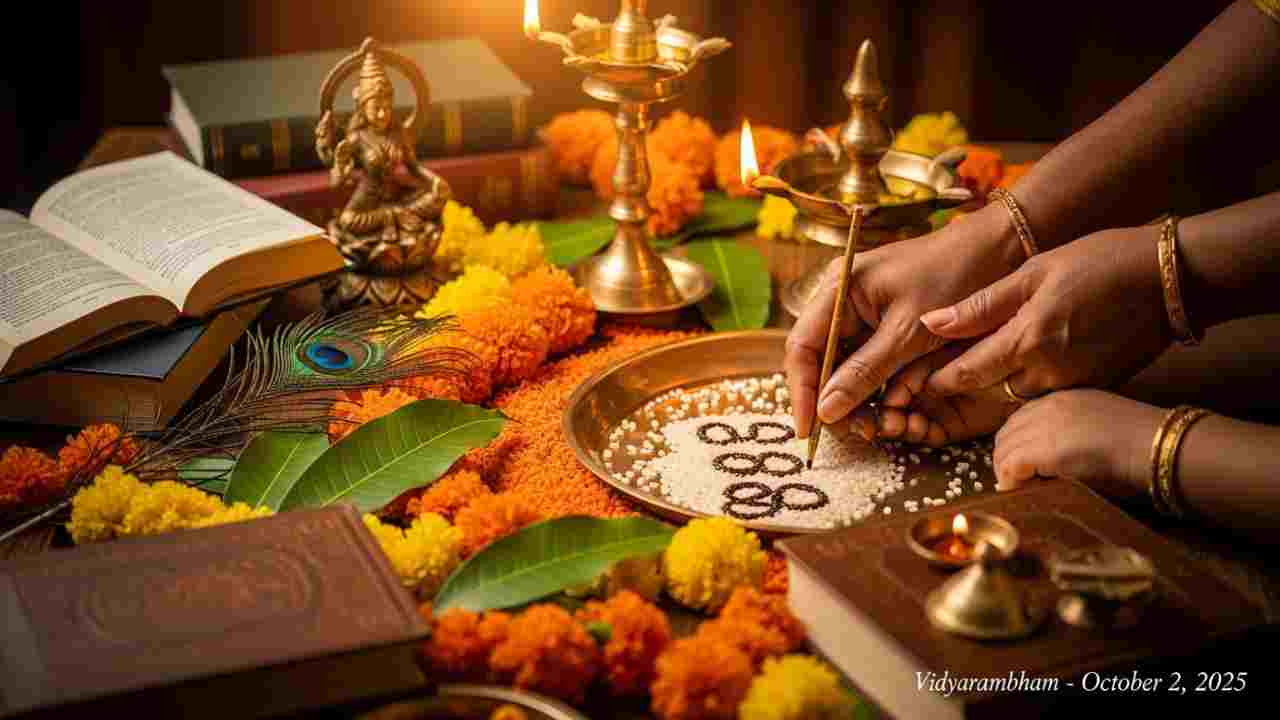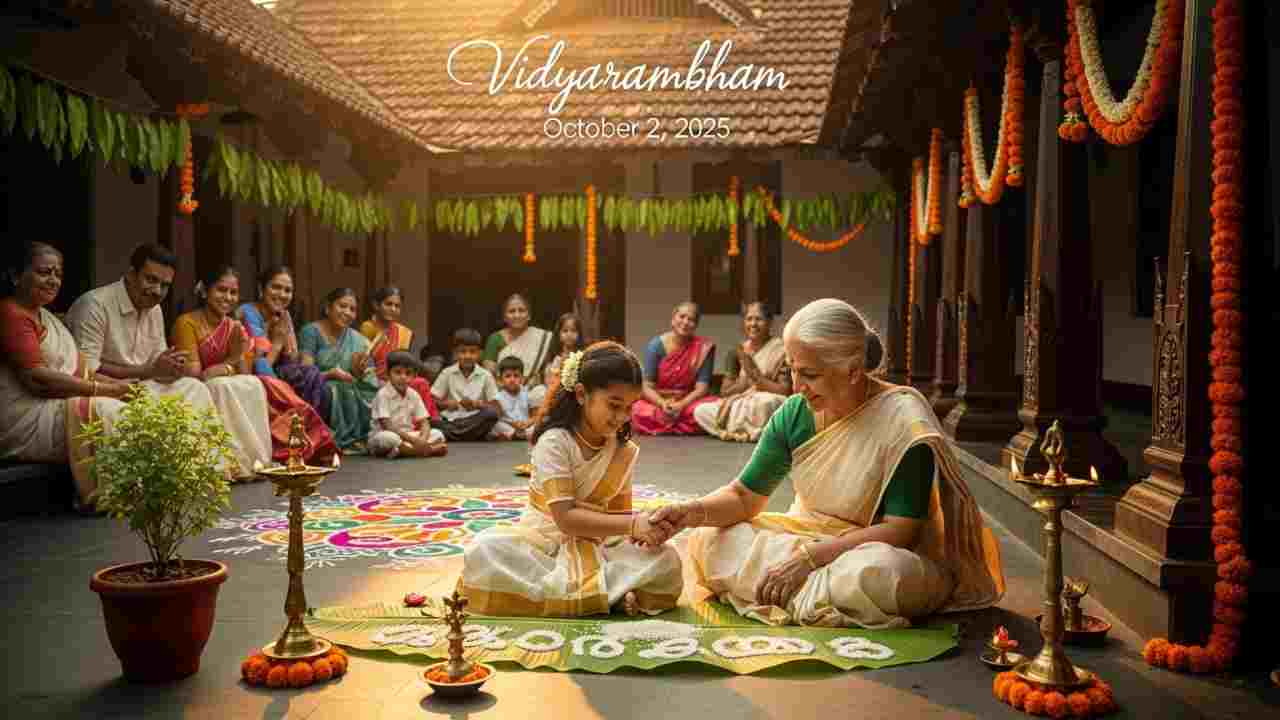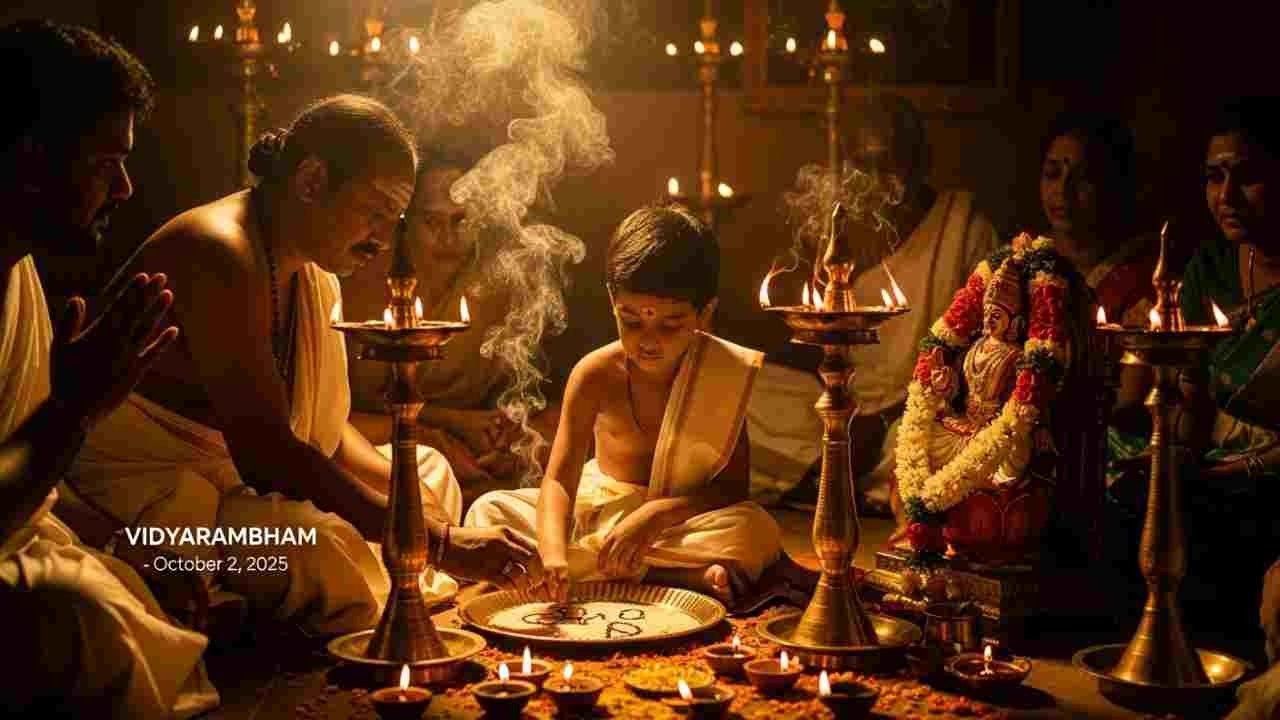
Have you ever wondered about the most auspicious way to introduce a child to the world of letters and knowledge? In Hindu tradition, this initiation is celebrated through Vidyarambham (also spelled Vidyarambham or Vidyarambhanam), a ritual that marks the formal beginning of a child’s education. Rooted deeply in devotion and symbolism, it emphasizes that all learning is an offering to Goddess Saraswati. The goddess of wisdom, arts, and learning.
In 2025, parents across India, especially in Kerala and among Hindu communities worldwide, will ask one important question: When is Vidyarambham in 2025? The answer carries not only a date but also layers of spiritual meaning.
This blog will explore the exact date of Vidyarambham in 2025, its rituals, cultural importance, and the Panchang (Hindu calendar) details behind choosing this day.
When is Vidyarambham in 2025?
The auspicious date for Vidyarambham in 2025 is:
Thursday, 2nd October 2025
This day coincides with Vijayadashami (Dussehra), one of the most sacred festivals in Hindu culture. Traditionally, Vidyarambham is observed on Vijayadashami because it symbolizes the victory of good over evil and the triumph of knowledge over ignorance.
Thus, Vidyarambham in 2025 will be celebrated with great devotion and enthusiasm on 2nd October, across Kerala, Karnataka, Andhra Pradesh, Tamil Nadu, and among Indian communities worldwide.
Why Vijayadashami is Chosen for Vidyarambham?

You might wonder, why is Vijayadashami considered the most auspicious day for Vidyarambham? Here’s why:
- Victory of Knowledge over Ignorance – Vijayadashami marks the day Goddess Durga defeated Mahishasura. Symbolically, it represents the triumph of wisdom and righteousness.
- End of Navaratri – After nine nights of worshipping the divine feminine, the tenth day (Vijayadashami) is ideal for initiating a child into learning.
- Blessings of Goddess Saraswati – In many traditions, books and instruments are kept in front of Goddess Saraswati during Navaratri. On Vijayadashami, these are taken back, and children are introduced to studies.
Therefore, beginning education on this day ensures that knowledge is pursued with divine blessings.
Other Auspicious Days for Vidyarambham in 2025
Although 2nd October 2025 (Vijayadashami) is the most celebrated date, Vidyarambham can also be performed on other auspicious days depending on the child’s Janma Nakshatra (birth star) and family traditions. Some favorable occasions in 2025 include:
- Vasant Panchami (dedicated to Goddess Saraswati)
- Akshaya Tritiya (day of prosperity and endless blessings)
- Lalita Panchami
- Guru Panchami
- Days with Moola Nakshatra during Navaratri
- Any day in Shukla Paksha (waxing moon) chosen via Panchang
Thus, while Vijayadashami remains the most popular, families may consult astrologers or follow their traditions to choose the right date.
Rituals of Vidyarambham

The Vidyarambham ceremony varies across regions, but its essence remains the same, the initiation of a child into the world of letters. Let’s look at the common steps:
- Preparation – The ritual is usually performed in temples, cultural halls, or at home. A sacred space is decorated with flowers and pictures/idols of Goddess Saraswati.
- Worship – Priests or elders conduct a puja, invoking the blessings of Goddess Saraswati, Lord Ganesha, and family deities.
- The Writing Ritual (Ezhuthiniruthu in Malayalam) –
- The child is seated on the lap of a guru, parent, or elder.
- The elder holds the child’s hand and helps write the first letters.
- Traditionally, the first words written are “Hari Shree Ganapathaye Namah” (salutations to Lord Ganesha).
- In Kerala, the letters are written on a tray filled with rice, or on the child’s tongue with a golden ring.
- The child is seated on the lap of a guru, parent, or elder.
- Blessings – Elders bless the child with sweets, fruits, and gifts, wishing success in studies and wisdom in life.
- Cultural Programs – In many temples, Vidyarambham is accompanied by classical music, dance, and storytelling, linking art with education.
Vidyarambham in Kerala
Kerala is the cultural heartland of Vidyarambham celebrations. On Vijayadashami, thousands of children gather at famous temples like:
- Thunchan Parambu, Tirur – The birthplace of Thunchath Ezhuthachan (father of Malayalam language).
- Dakshina Mookambika Temple, North Paravur
- Panachikkadu Saraswati Temple, Kottayam
- Mookambika Temple, Kollur (Karnataka, but popular among Malayalis)
In these places, Vidyarambham in 2025 will witness grand rituals, where children write their first letters on rice under the guidance of priests and scholars.
Cultural Significance of Vidyarambham

Vidyarambham is not merely a ritual; it embodies profound cultural and spiritual values:
- Respect for Knowledge – It teaches that learning is sacred and begins with humility before the divine.
- Guru-Shishya Tradition – The involvement of elders or teachers in guiding the first letters reflects India’s deep-rooted tradition of honoring gurus.
- Connection to Arts – Vidyarambham is also associated with initiating children into music, dance, and classical arts.
- Equality in Learning – In temples, children from all communities gather for Vidyarambham, symbolizing that knowledge is universal.
Vidyarambham Mantras and Chants
During Vidyarambham, special mantras are recited to invoke Goddess Saraswati and seek blessings:
- Om Saraswatyai Namah – Salutations to Goddess Saraswati.
- Saraswati Mahabhage, Vidye Kamala Lochane, Vidyarupe Vishalakshi, Vidyam dehi namostute – A prayer to grant wisdom and learning.
These mantras fill the atmosphere with spiritual energy, ensuring that the child’s education begins on a pure note.
Modern Adaptations of Vidyarambham

In today’s world, while traditional rituals continue, families have also adapted Vidyarambham in creative ways:
- Performing it at home with simple prayers.
- Using modern tools like slates, whiteboards, or tablets instead of rice trays.
- Conducting online Vidyarambham for families abroad, where priests guide the ritual virtually.
- Schools organizing special cultural events for children to honor the tradition.
Thus, Vidyarambham in 2025 will be celebrated both traditionally and in modern forms, ensuring its relevance for every generation.
Lessons from Vidyarambham
Vidyarambham teaches timeless values:
- Learning is sacred – Knowledge is not just academic; it’s spiritual.
- Humility before learning – One must start education with respect and devotion.
- Continuous growth – Vidyarambham is a beginning, reminding us that learning is lifelong.
- Unity in culture – The ritual shows how communities across India unite in honoring knowledge.
So, to answer the central question: When is Vidyarambham in 2025?
Thursday, 2nd October 2025 (Vijayadashami) is the most auspicious and widely celebrated day for Vidyarambham.
Whether performed in Kerala temples, at home, or in schools, this ritual holds deep spiritual meaning. It is a reminder that education is not just about academics but about connecting with wisdom, culture, and divinity.
As you prepare for Vidyarambham in 2025, may the blessings of Goddess Saraswati guide every child towards a life filled with knowledge, wisdom, and success.
FAQs
1. When is Vidyarambham in 2025?
Vidyarambham in 2025 falls on Thursday, 2nd October 2025, which is also Vijayadashami (Dussehra). This is the most auspicious day for the ritual.
2. What is the significance of Vidyarambham?
Vidyarambham marks a child’s initiation into learning. It symbolizes respect for knowledge, the blessings of Goddess Saraswati, and the importance of education in one’s life.
3. Can Vidyarambham be done on days other than Vijayadashami?
Yes. While Vijayadashami is the most popular day, Vidyarambham can also be performed on Vasant Panchami, Akshaya Tritiya, Lalita Panchami, Guru Panchami, or days with Moola Nakshatra during Navaratri, depending on family traditions and astrological advice.
4. How is Vidyarambham performed?
The child is seated on the lap of an elder or guru. With guidance, the child writes their first letters (traditionally “Hari Shree Ganapathaye Namah”) on a tray of rice, on sand, or sometimes on a slate. Mantras are chanted, and blessings are given.
5. Where is Vidyarambham most widely celebrated?
Vidyarambham is especially popular in Kerala and among Malayali communities worldwide. Major celebrations take place at Thunchan Parambu (Tirur), Panachikkadu Saraswati Temple (Kottayam), and Dakshina Mookambika Temple (North Paravur).
6. What is written first during Vidyarambham?
Traditionally, children write the phrase “Hari Shree Ganapathaye Namah” (Salutations to Lord Ganesha) as their first words. In some traditions, just the letter “A” or the Sanskrit “Om” is written.
7. Can Vidyarambham be done at home?
Yes, Vidyarambham can be performed at home with simple rituals. Families create a small altar with Goddess Saraswati’s image, offer prayers, and guide the child in writing their first letters.
8. What is the best age for Vidyarambham?
Most families perform Vidyarambham when a child is around 2 to 5 years old, though the exact age may depend on cultural practices and astrological advice.
9. Is Vidyarambham only for learning letters?
No. While it begins with writing, Vidyarambham also signifies the start of learning in music, dance, and other traditional arts, especially in Kerala.
10. Why is rice used in Vidyarambham?
Rice symbolizes prosperity, purity, and nourishment. Writing the first letters on rice signifies a foundation of abundance and positivity in the child’s educational journey.

